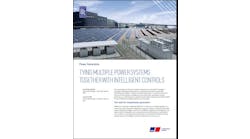How Are California’s PSPS Policies Failing to Stem Fire Damage? SimpliPhi Power Explains
“In California, PSPS are being marketed as a way to keep the public safe by shutting off the power to prevent forest fires,” said Von Burg as part of the Microgrid Knowledge Executive Interview Series. Utilities shut down distribution lines to avert sparking fires from their electrical equipment during fire season.
“The truth is, there are billions of economic losses as a result of shutting off the grid,” she said.
In 2020, in California alone, the state had 9,900 fires. Of that number, 700 fires were sparked by utility infrastructure. But utilities only executed 25 PSPS events that shut off power lines.
“How is it that PSPS events are really protecting the public from a public safety standpoint?” asked Von Burg.
Rather than embracing the idea that PSPS are solutions to fire threats, policymakers need to focus on the root causes of the problems troubling California and other fire-prone areas. Those challenges include drought and heat spurred by climate change.
They also should encourage technologies that provide electric resilience. SimpliPhi Power is installing customer-sited assets, especially storage, to create resilience during wildfires.
But obstacles stand in the way of widespread adoption of electric resilience. Among them are codes and compliance policies, including those from utilities, that reate barriers to getting customer-sited distributed assets online.
“This is an example of how policy is not supporting direct real world solutions to create energy security and resilience for mitigating climate change, the very cause of what’s happening,” Von Burg said.
Humanitarian projects
Not only does SimpliPhi Power focus on finding ways to create resilience in the face of climate change, but the company also often chooses projects with a humanitarian focus. For example, a SimpliPhi Power donation program that aims to provide clean energy to communities in need will send energy storage systems to an orphanage in Haiti and a Covid response center in Myanmar. The donations are through “IDEA: a campaign to Deliver Energy Access,” an initiative SimpliPhi Power started in January with several partners.
The company also is a partner in a project that aims to install 750 minigrids in the Central African country of Cameroon, where electricity is scarce outside of major cities.
“When we founded the company in 2010, we decided that projects really should be in service of making a difference. You need to create solutions to existing problems or challenges,” said Von Burg.
SimpliPhi is helping with a minigrid effort to light up the 11,000 villages in Cameroon. Photo courtesy of SimpliPhi
While SimpliPhi Power projects are generally driven by their ability to yield income, the company also looks at how the projects will generate an impact above and beyond revenue. As part of its work, the company seeks partnerships that provide synergies among partners, including for profit and nonprofit entities.
The federal government has recently increased its focus on such humanitarian efforts, thanks to the Biden administration’s concentration on equity in energy policy. In some ways, the administration’s thinking about access to energy through an equity lens is groundbreaking. It’s also important, said Von Burg.
And yet, energy policy efforts at the state and federal level don’t go quite far enough. California policymakers’ use of PSPS is one example.
“It’s an example of how policymakers don’t seem to understand how critical resilience is, along with issues around energy and access and mitigating increasing levels of carbon dioxide,” said Von Burg.
How SimpliPhi would spend a jackpot
When asked what she would if she received a large check from a benefactor to use any way she wanted, she said she’d take part in projects that prove new business models and technologies, she said.
“To leverage that money, it would be about proving out a model that could then be deployed in other places,” she said. For example, in California, that might mean creating a new energy market involving both utilities’ centralized assets and decentralized customer-sited distribution assets. Such projects would prove the economic viability of the model, for the US as well as other countries.
“That type of model applies in large swaths of different continents that don’t have access to centralized resources. It proves out renewable and distributed assets and the type of economic development potentiated by those types of assets,” said Von Burg.
And, like much of SimpliPhi’s work, such projects would do good in the world.
Tracks news about SimpliPhi Power. Subscribe to the free Microgrid Knowledge Newsletter.








